Overview
Cadence Reality DC Design - [omni.kit.cadence_reality_dc_design]
Cadence Reality DC Design is the industry leading data center CFD (computational fluid dynamics) tool, built for data center design and operations. With the NVIDIA Omniverse Cadence Reality DC Design Extension, you can import entity models along with their properties and CFD simulation results from Cadence Reality DC Design into Omniverse. Visit the extension user manual to learn more about its features.

User Manual
Pre-Requisites
Cadence Reality DC Design installation is required. You can register and create a Cadence account at https://registration.cadence.com/CadenceApplicationRegScreen?appcode=cdotcom&langcode=en and register in Cadence Support Portal at https://support.cadence.com/apex/HomePage to download the software.
Enable Cadence Reality DC Design Extension
The Cadence Reality DC Design Extension is not enabled by default in Extensions Manager and will need to be enabled for use.
Click on Window > Extensions to open the Extensions Manager
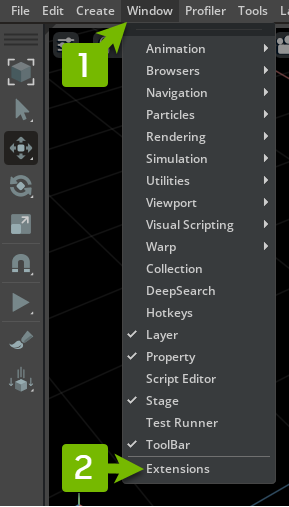
Install and enable the Cadence Reality DC Design Extension.
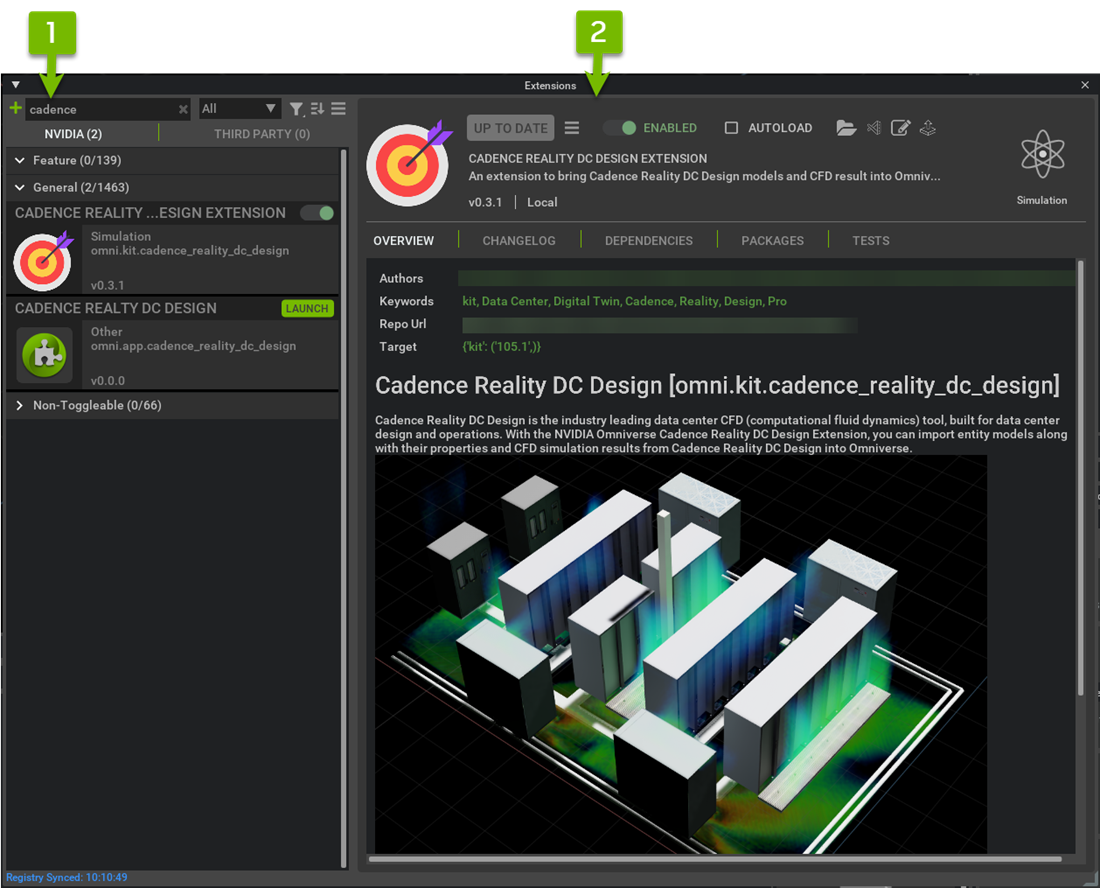
Click on Window -> Cadence Reality DC Design Extension to open the Extension Window.

User Interface
A floating window is shown after toggling on the Cadence Reality DC Design Extension option. Currently the extension supports two main features which allow users to import models from Cadence Reality DC Design via the Import tab or view the properties of the imported models under the Properties tab.
Import tab
The Import tab provides users the ability to import models and CFD results into Omniverse. These default options are shown initially to the users.
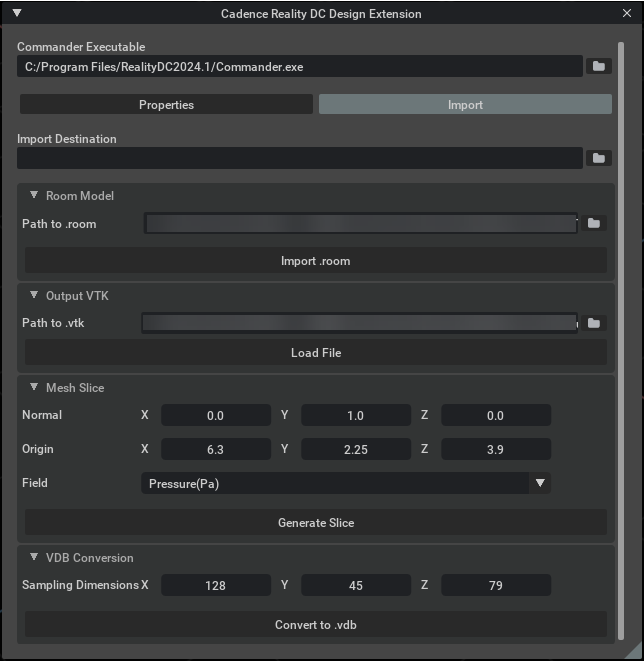
Element |
Description |
|---|---|
Commander Executable |
The path to the Commander executable file. Commander is the tool that acts as a communication bridge between Omniverse and Cadence Reality DC Design Pro. |
Import Destination |
The path to the directory to store the converted files. Support both local file system path and Nucleus URL. |
Path to .room |
The path to the Cadence Reality DC Design’s model .room file. |
Path to .vtk |
The path to the .vtk output generated by Cadence Reality DC Design. |
Additional options are shown after the extension loads .vtk file into memory.
Mesh Slice Panel Element |
Description |
|---|---|
Normal |
Normal vector of the slice to generate. |
Origin |
Origin of the slice to generate. |
Field |
Scalar field to apply for color mapping. |
VDB Panel Element |
Description |
|---|---|
Sampling Dimensions |
Sampling dimension x, y, z for the result .vdb file |
Properties tab
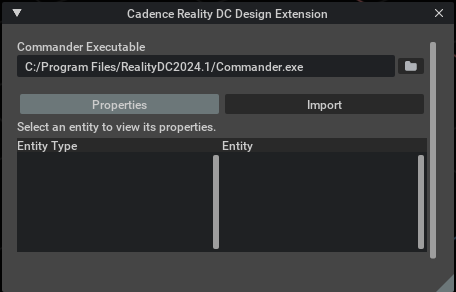
Element |
Description |
|---|---|
Entity Type |
Displays a list of entity types available in the opened stage |
Entity |
Display a list of entities filtered by the selected entity type. |
Attributes Panel |
Shows entity attributes on entity selection. Initially hidden below the Entity Type and Entity List Views. |
Use the Extension
Import .room Model
It’s highly recommended to go through the basic tutorials which can also be downloaded with Cadence Reality DC Design installation. In this guide we’ll go over how to import the models from Tutorial 3 provided by Cadence.
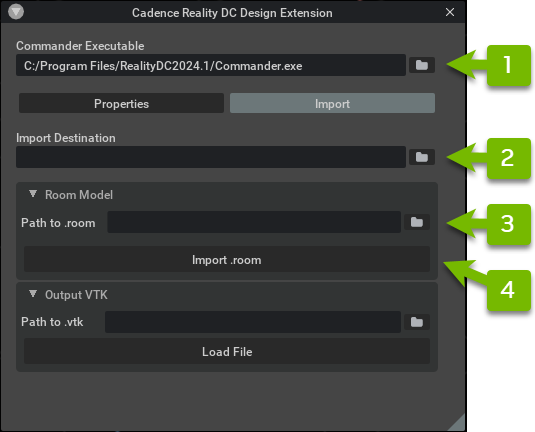
Click on the Commander Executable text field or the browse button to set the path to the
.exefile. This is the process that the extension uses to export models and properties from Cadence Reality DC Design Pro.Click on the Import Destination text field or the browse button to set the directory to write the converted models.
Click on the Path to .room text field or the browse button to set the path to Tutorial3.room file. By default, the file is located at C:\Program Files\RealityDC
\TutorialCases\DataCenterDesignPro\Tutorial3.room but it may be different for users who installed Cadence Reality DC Design and the tutorials under another location.Click the Import .room button to start the importing process. A progress bar will be shown and more detailed conversion status can be seen from the console.
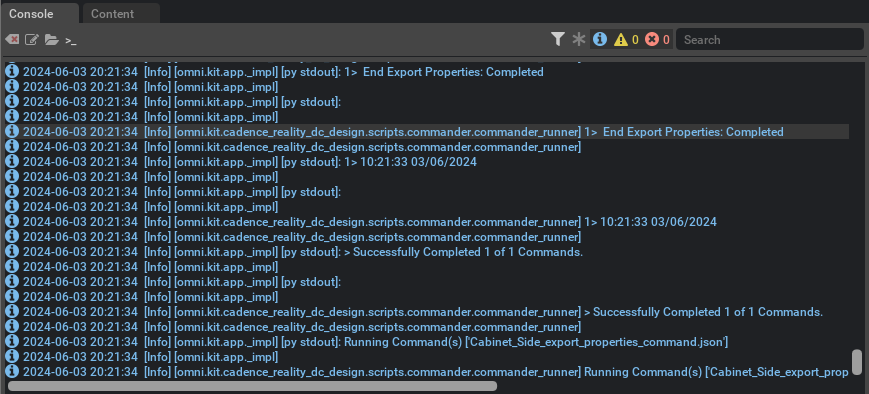
Once the import process is done, we can see the converted models inside the viewport.
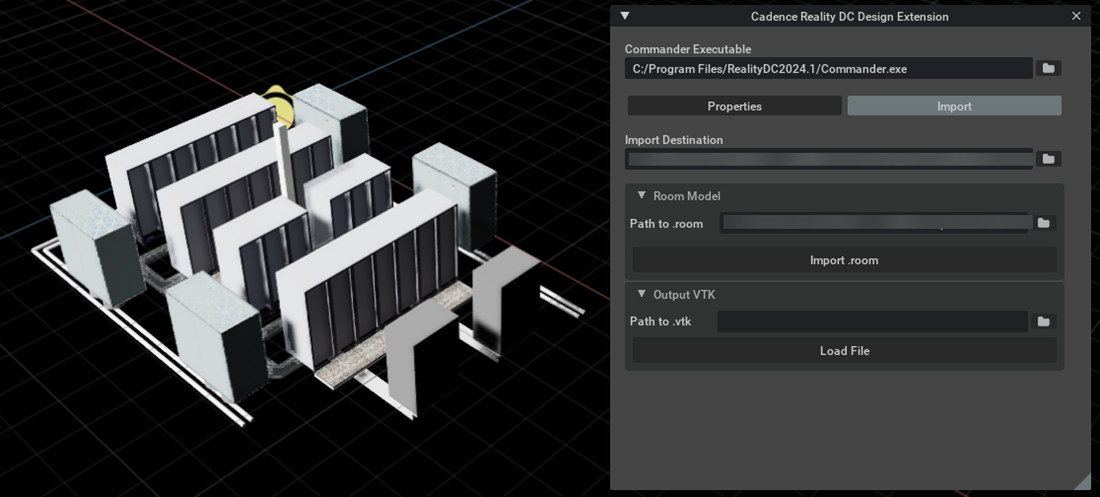
Import Cadence Reality DC Design’s result .vtk
Mesh Slice Visualization
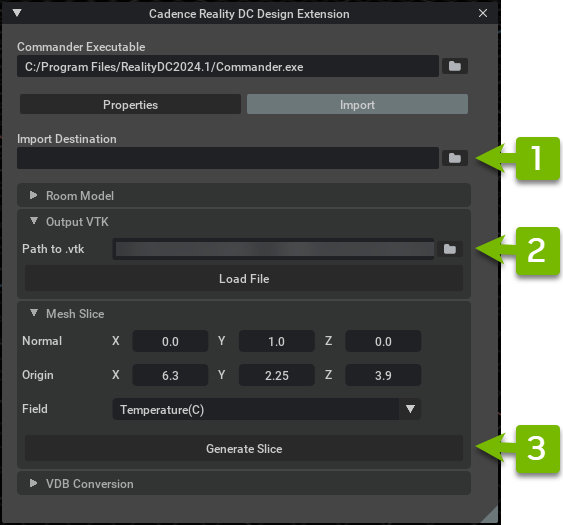
Click on the Import Destination text field or the browse button to set the directory to write the converted mesh.
Click on the Path to .vtk text field or the browse button to set the path to the .vtk generated by Cadence Reality DC Design.
Additional panels, such as the
Mesh SliceandVDB Conversion, are shown after the files are loaded. Set the desired normal, origin, and scalar field for the slice and click the Generate Slice button.
The resulting slice is shown in the Viewport once the conversion is complete. In addition, the users can click anywhere within the volumetric bound to query for CFD profile readings after loading the .vtk file when All Prim Types is selected as the selection mode in the application.

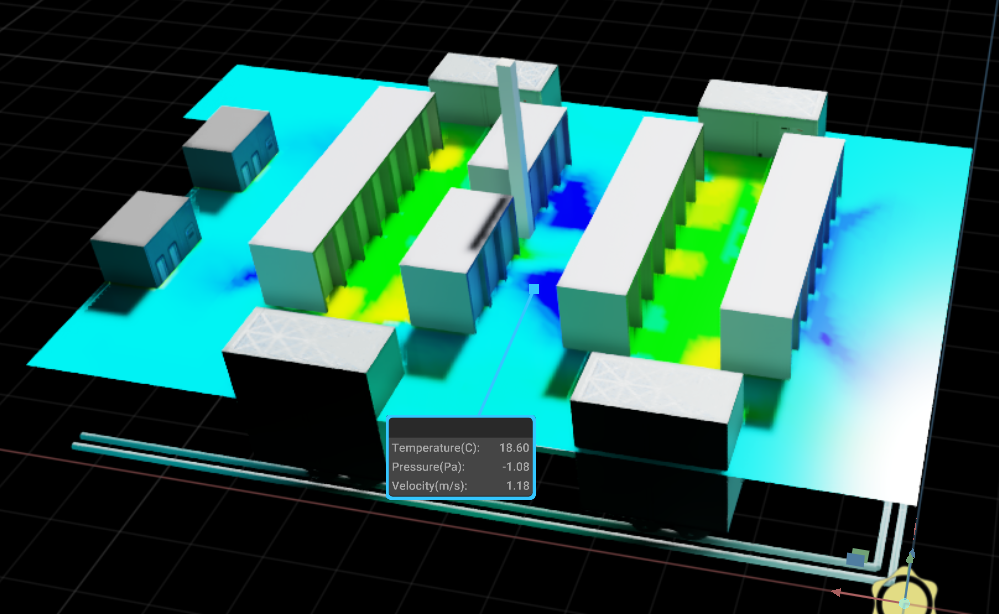
Flow Visualization
We will utilize
omni.flowusdExtension for air particle flow rendering. Open extensions manager to ensure thatomni.flowusdis enabled and up to date.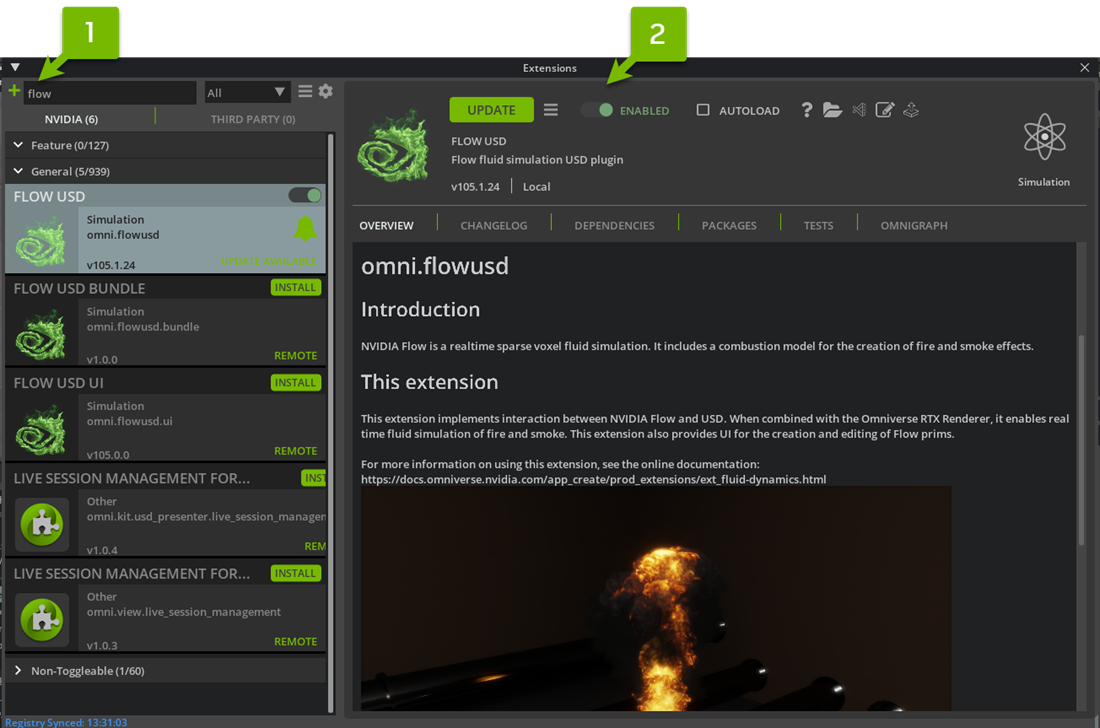
Enable Flow under Render settings
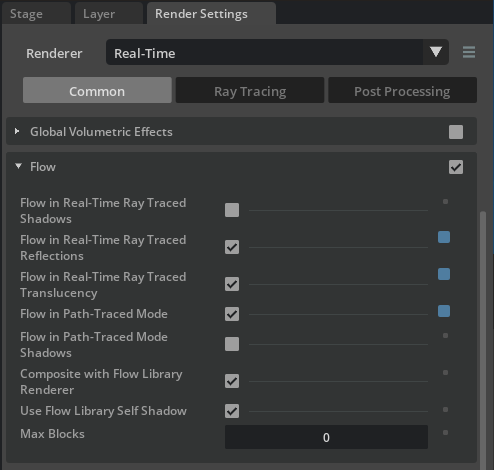
Upon
.vtkfile load completion, aVDB Conversionpanel is shown with integer fields pre-populated according to the simulation domain size. Change the sampling dimensions to the desired values and click the Convert to .vdb button to start the conversion process.
Create NanoVDB emitter, FlowSimulate, FlowOffscreen, and FlowRender prims from
Create/Flowmenu then place the NanoVDB emitter under an :term:Xform<XForm>scaled up by (100, 100, 100)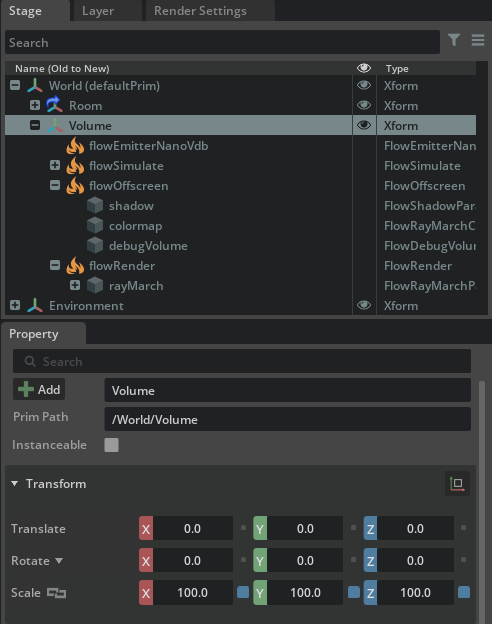
Select flowSimulate and set Density Cell Size to 5.0
Select flowSimulate/advection and set Gravity to (0, 0, 0)
Click the Play button or toggle on Force Simulate property under flowSimulate to see the effects from updating settings in real time.
Select flowEmitterNanoVdb and navigate to Velocity Channel settings. Change Velocity Scale to 8, Asset Path to the converted
.vdbfile path, and Grid Name to Velocity(m/s)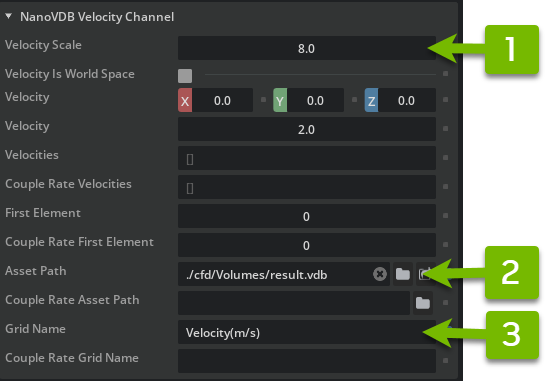
Navigate to Smoke Channel settings under
flowEmitterNanoVdband change Smoke target value to 1.0Select flowOffscreen/debugVolume prim and toggle on Enable Speed as Temperature checkbox.
Select flowOffscreen/colormap prim and change Color Scale to 14, add a blue control point at position 0.05 with 0 alpha, add a green control point at position 0.1 with 0.1 alpha, and add a red control point at position 0.35 with 0.75 alpha.
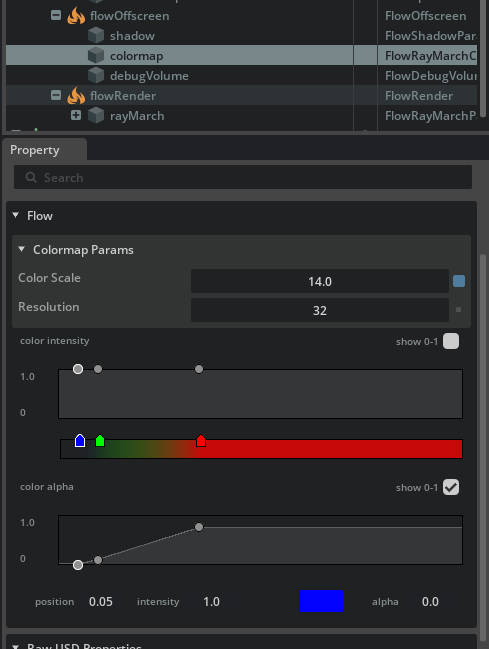
The result should look like the image below. Please refer to the Omniverse Flow guide at Using Omniverse™ Flow to learn more about the Flow extension.
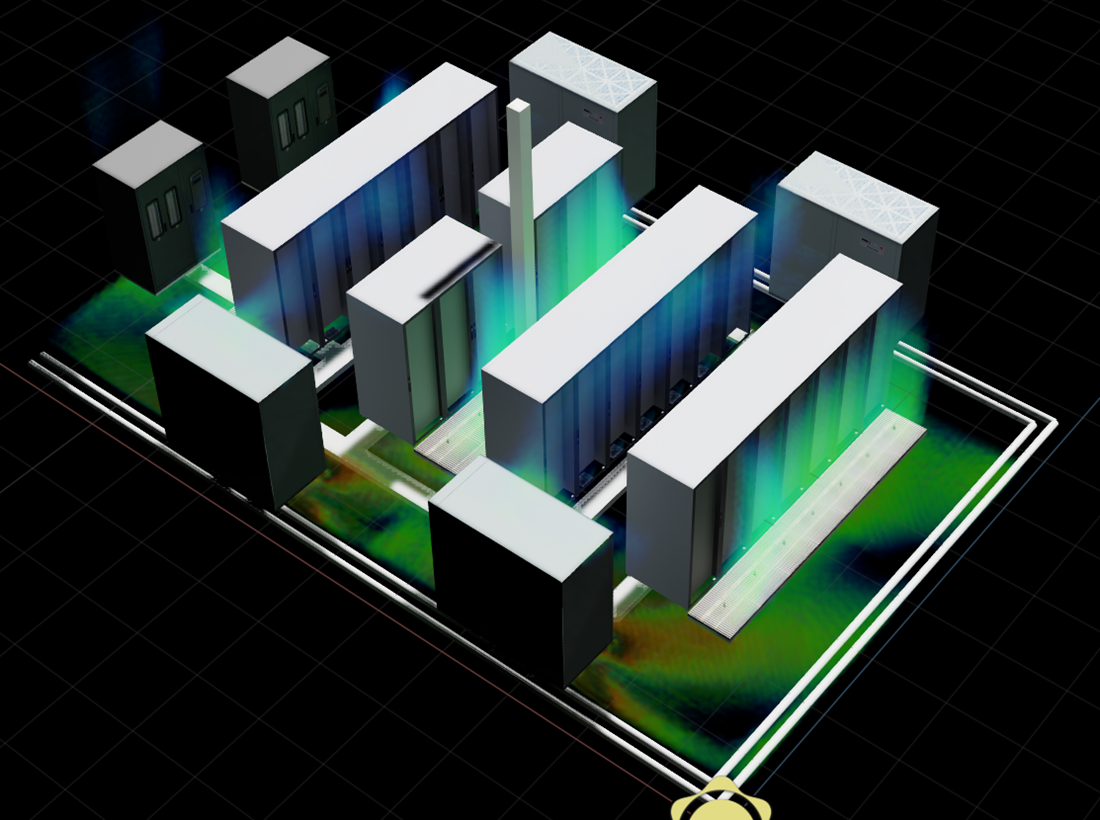
View Imported Properties
The Properties tab is where the Extension displays imported properties from Cadence Reality DC Design. First, we select an entity type of interest from the left tree view. All entities of that type will be listed in the right tree view for selection. Optionally, you can also click on an entity inside the Viewport to see its properties.
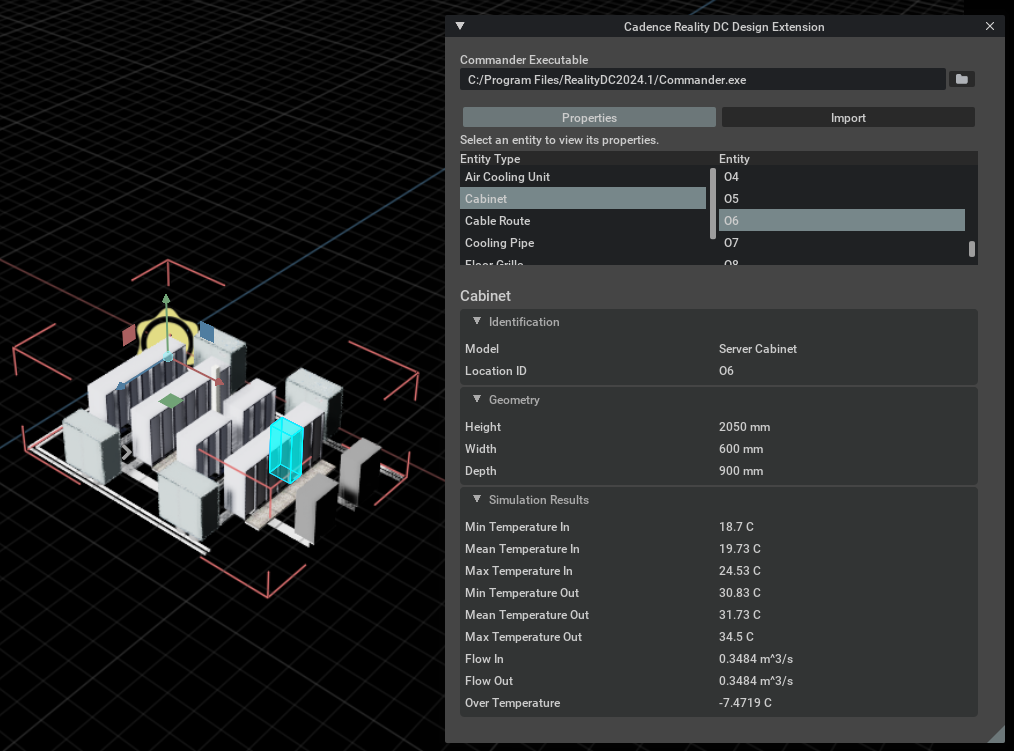
Attributions
Troubleshooting
Failed to solve all extension dependencies
Cadence Reality DC Design extension needs the following dependencies:
omni.kit.asset_converter v2.1.13 and up
omni.kit.converter.vtk v3.0.4 and up
If the application has an older version of them enabled, Failed to solve all extension dependencies error may arise upon installing or enabling the Cadence Reality DC Design extension. In order to resolve the issue, we need to disable the outdated dependencies or update them to the latest prior to enabling the Cadence Reality DC Design extension.